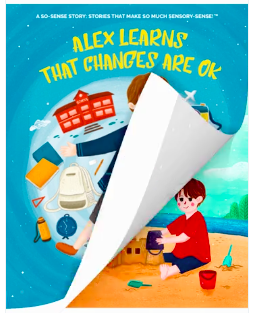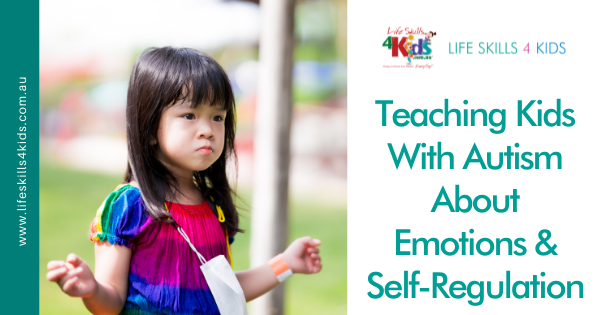Are you a professional who is teaching kids with autism? Are you struggling to teach them about emotions and self-regulation?
At LifeSkills4Kids, we have experience of teaching kids with autism and our aim is to share our strategies to help you, as a professional, achieve the most with every one of the autistic kids that you teach.
Introduction
Children with autism struggle to understand:
- How they feel
- How others feel
- How to interpret visual cues of how others feel
Teaching Kids With Autism
As a professional, teaching kids with autism can be a challenge. We all acknowledge that the children we teach are unique individuals. As facilitators, we want to teach each and every one of them how to achieve to their fullest potential possible.
Visual Supports For Teaching Kids With Autism
There are a variety of visual cues that can help when teaching kids with autism. A visual cue can help the young person to make sense of their routine and provide boundaries and security. When autistic kids are cued into an activity, it is often much more successful.
For further reading, have a look at our article on visuals in schools.
Examples of Visuals To Help Teach Self-Regulation & Emotions
1. Boardmaker pictures
- The practitioner can use a variety of programs to make up simple (and more complicated) communication boards.
- If part of your professional team includes a Speech and Language Therapist (SaLT), this person would be the ideal expert to learn about and experiment with communication boards.
- As part of a multi-disciplinary team, it is important to agree on which program you use. Consistency for the child is very important and ideally, the same visual boards will be used in all settings.
- For example, some practitioners believe that symbols should be in colour, others believe that symbols are less busy if they are in black & white.
- Once you have decided on the symbols program to use, you can build this into a child’s education.
- Visual symbols can be used with groups or individuals.
2. Social Stories
- A Social Story can provide a framework of information for children with autism.
- The child can use a Social Story to find out what might happen in a specific situation and also provide some guidelines of what behaviour could be acceptable in this situation.
- By increasing the structure in the young person’s life, a reduction in anxiety is often noticed.
- Social Stories can be very helpful in allowing kids with autism to self-regulate.
3. Emotions thermometer
- An image of a thermometer can be a useful tool to encourage a child to “measure” their emotions.
- If the temperature is quite low, then the child is happy and more relaxed.
- An increase in temperature shows that the child is becoming more anxious and less happy.
4. Fast, slow, just right visual model, eg, SticKids
- Stickids provides a system of planners and Stickids pictures to develop and create a visual timetable for the young person.
- The program includes frameworks to promote self-regulation and self-modulation.
- Stickids also provides a “Critter” meter and effect icons which give you an indication as to what the activity will do for the child. (This splits into fast, slow or just right).
5. High, just right, low visual model, eg The Alert Program
- The Alert Program uses this quote: “If your body is like a car engine, sometimes it runs on high, sometimes it runs on low, and sometimes it runs just right!”
- This program focuses on the “state” an individual is in and what the optimum states are for various activities.
- For example, we want to be in a low state to fall asleep at night. At work or school finding the sweet spot of being optimally alert is ideal. An example of high state could be in the audience of a sports game when your favourite team has just scored.
6. Zones of regulation program
- Zones of regulation is a framework to foster self-regulation and control.
- There are four zones:
- Red is an extremely heightened state eg terror, rage, anger
- Yellow is still heightened eg anxiety, frustration
- Green is a calm state, where optimal learning occurs.
- Blue is a low state eg sad, sick, tired
7. Just Right Kids Model which combines fast, slow, just right
- The Just Right Kids Technique is the product of 17 years of learning from children & adults.
- It stands on the shoulders of some of the above programs.
- It incorporates fast, slow, just right and teaches children interactively to learn these concepts.
Why Should You Use The Just Right Kids Self-Regulating Technique?
As professionals, we all want to work with kids to help them be happy, comfortable and content in their lives. It can be a struggle for kids at both school and home to feel like they are OK and coping with the daily demands of life.
It is by providing strategies and techniques that we can enable our wonderful young people to become successful and happy.
When we help kids put the pieces of the puzzle together, they have a pathway to move along. By understanding the nervous system, children can be easily taught to understand their emotions and the basis for concentration. This is a crucial lifeskill to enable all kids to thrive in their world.
What Is the Just Right Kids Technique?
There are six main concepts that we need to teach children for this technique of being aware of their emotions and for self-regulation. Once children understand the basics of these six areas, we can use the Just Right Kids Technique to practice self-regulation of activity levels and their emotional states, leading to better self-control and less meltdowns and tantrums.
The Six Areas of Self-Regulation
1. When my body is going fast
- Our bodies are going fast when we are excited, happy, have lots of energy.
- This can cause a level of alertness that is too high to sit down (and this may cause us to get into trouble!)
- Our thinking can be unclear and it is difficult to concentrate.
2. When my body is going tired / slow
- We might find it hard to get up in the morning.
- We might be lethargic and going too slow all day.
- We can be under responsive and perceived as being “lazy”.
3. When my body is angry
- I feel stressed out and on high alert.
- I can’t control my body, I am reacting to an event and might feel hard done by.
4. When my body is in meltdown or tantrum mode
- I am in overwhelm and my senses are frazzled.
- I might be in the meltdown zone.
- I might be in the tantrum zone and I’m trying to take back some control.
- This zone could quickly disintegrate into the sad or angry zone.
5. When my body is sad / slow
- I feel sad, curl up or have a cry.
- I might be recovering from a meltdown.
- I might be tired or sad.
6. When I am a ‘just right’ kid
- When I am feeling ‘just right’ I feel safe, happy and emotionally okay.
- I have the right attitude to life.
- I can concentrate, listen and understand what is happening around me.
The goal of the Just Right Kids Technique is that kids are just right for most of the time. When we are teaching kids with autism to self-regulate we can use visual cues, symbols and planners to help them.
ALEX LEARNS FLIPBOOK
Alex loves school. He enjoys all the activities he does during the term such as swimming and soccer. He also loves holidays and all the fun things he gets to do while he’s not at school. The problem is, Alex doesn’t like changes. His tummy gets all tight and he gets a worry cloud that comes over his brain and makes it feel foggy. When the school term ends and holidays begin or when school is about to start again, Alex feels really worried and anxious.
When you purchase the Alex Learns that Changes are OK (Flipbook), you will receive a digital flipbook that gradually changes from one page to the next while listening to high-quality audio narration as if someone is flipping and reading the book for you!


